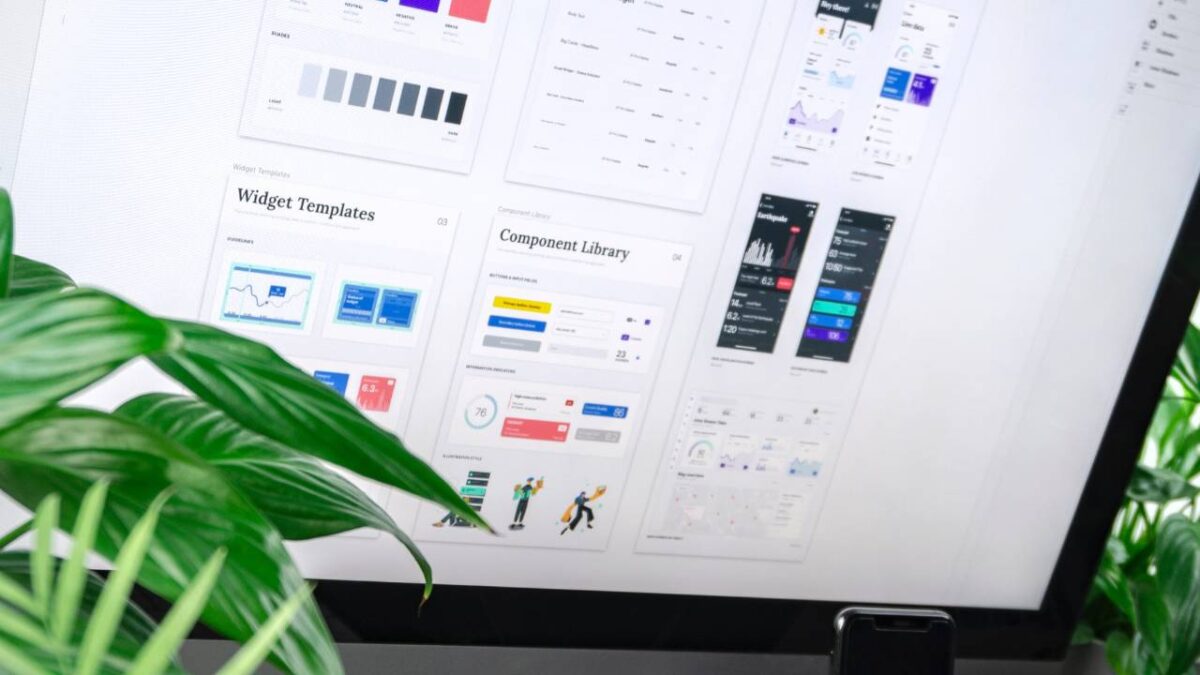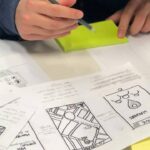Entering the world of web design can be an exciting yet overwhelming experience for beginners. With countless tools, techniques, and resources available, it’s essential to start with a strong foundation. The digital canvas offers endless creative possibilities, and understanding the basics of web design will empower you to showcase your ideas or business online effectively.
While the aesthetics of web design are important, focusing on the user experience and functionality of your website is equally crucial. Taking the time to learn about essential design principles, colour psychology, typography, and layout can greatly improve your website’s overall appeal and usability. Furthermore, familiarising yourself with design trends and seeking inspiration from renowned designers will help keep your work fresh and visually engaging.
Key Takeaways
- Master the fundamental principles of web design for effective online presence
- Prioritise user experience and functionality alongside visual appeal
- Learn from design trends and gain inspiration from established professionals
Web Design Basics

Understanding User Interface (UI) and User Experience (UX)
In web design, it’s crucial to create a balance between the user interface (UI) and user experience (UX). UI refers to the visual elements of a website, while UX deals with how users interact with and navigate through the site. As a beginner, it’s essential to understand the basics of both UI and UX. You should strive to create a visually appealing site that provides a seamless experience for your visitors.
Key Elements of Web Design
Here are some of the most important elements to consider when designing a website:
- Content: Ensure your content is relevant, informative, and engaging for your target audience. Keep the copy clean and concise, breaking it up with headings, bullet points, and images where appropriate.
- Features: Include features such as menus, icons, and buttons to enhance your site’s functionality and improve navigation.
- Visual Elements: Use eye-catching images, colours, and typography to create a visually appealing site that stands out.
- Accessible Design: Ensure your website is accessible to all users, including those with disabilities.
The Importance of Website Layout
An effective website layout is crucial for guiding your visitors’ attention and making your content easy to consume. Here are some key aspects of a successful layout:
- Columns and Rows: Organise your content in a grid system with columns and rows to create a clean and structured layout.
- Balance: Strike a balance between your text and visual elements, creating focal points to draw the visitor’s eye.
- Negative Space: Don’t forget to incorporate negative or whitespace in your layout to provide breathing room for your content.
- Contrast: Use contrast to make your text and visual elements stand out against the background.
Web Development Languages
To bring your web designs to life, it’s important to learn about the fundamental web development languages. The three primary languages are HTML, CSS, and JavaScript:
- HTML (HyperText Markup Language): This is the foundation of any website, defining the content, structure, and meaning of a web page.
- CSS (Cascading Style Sheets): CSS controls the presentation, styling, and layout of your website, allowing you to create visually appealing designs.
- JavaScript: This programming language enables you to add interactivity, dynamic content, and animations to your website, enhancing the user experience.
Beautifying the Web Space

Power of Typography and Text
Typography is a vital element of web design that drastically impacts your website’s visual style and composition. To ensure optimal readability, choose suitable fonts, sizes, and typefaces. Utilise headline hierarchy so your readers can easily navigate and grasp the content.
- Fonts and size: It is essential to use fonts that are easy to read on various devices. Opt for widely supported typefaces and keep the font sizes between 12 and 18 points.
- Typefaces: Limit the number of typefaces to two or three, creating a harmonious and consistent design.
Implementing Visual Hierarchy
Visual hierarchy plays a significant role in effectively organising your web layout. It establishes an order of importance within the elements, enabling the users to understand the content effortlessly.
- Hierarchy: Use elements such as size, colour, and placement to achieve a clear hierarchy in your design.
- Order: Prioritise content, considering which aspects require the most emphasis, and position them accordingly.
Role of Colour in Web Design
Colours evoke emotions and create a mood, making it necessary to carefully select a colour palette. Your website’s colour scheme should reflect your brand identity and appeal to your target audience.
- Contrast: Create a visually impactful layout by utilising contrasting colours, such as dark text on a light background.
- Colour palette: Use tools like Adobe Color CC to generate harmonious palettes, ensuring your colours work together seamlessly.
Incorporating Imagery and Icons
Visual elements such as photos, icons, and illustrations significantly enhance your website’s appeal. Strategically incorporate photography or custom-designed icons to accentuate your content and establish your unique style.
- Photos: Utilise high-quality, relevant images to represent your brand and messaging.
- Icons: Use custom icons to craft an exclusive, consistent look and improve user experience.
Principles of Balance and Spacing
Balance and spacing are essential in achieving a harmonious composition in web design. A well-executed layout incorporates negative space, ensuring your content is easily digestible and visually appealing.
- Balance: Distribute elements proportionately, striking equilibrium between text, images, and icons.
- Spacing: Apply appropriate margins and padding to create a sense of order, allowing users to focus on the content.
Web Design Inspiration

Seeking Inspiration from Other Designers
One of the best ways to improve your design skills and find inspiration is to learn from other designers in the field. Explore websites like Awwwards, Behance, and Dribbble to see what others have created. These platforms showcase hundreds of top-quality web designs, allowing you to study their techniques, admire their styles, and implement their ideas to refine your own projects.
Leveraging Design Tools
Using design tools is crucial for effectively translating your ideas into tangible web designs. Tools like Canva, Sketch, and Webflow offer pre-built templates, stock images, and various design elements to help speed up your creative process. Play around with these editor tools, explore different layouts, and incorporate elements like Material Design principles or responsive archetypes, if required. This hands-on experience with design tools will pave the way for improved design skills and better web design tips.
Utilising Courses and Tutorials
Investing time in courses and tutorials can strengthen your understanding of web design fundamentals. Various online resources offer free or paid courses and tutorials to help you learn valuable web design tips and develop your design skills. Platforms such as Coursera, Udemy, and YouTube feature comprehensive courses to support your journey from beginner to proficient web designer. Don’t hesitate to seek out these educational materials, as they can be essential for enhancing your capabilities and expanding your design toolbox.
The Business of Web Design

Brand Representation Through Design
In the world of web design, effectively representing your brand is crucial. As a beginner, it’s essential to understand the importance of incorporating your brand’s identity into your website’s design. To achieve this, consider your brand’s colours, logo, typography, and overall aesthetic. Consistently using these elements across your site helps in creating a cohesive and professional appearance.
Site Optimization for Search Engines
A well-designed website needs proper search engine optimisation (SEO) to rank higher in search results. As you work on your site, be mindful of incorporating relevant keywords, proper headings, and user-friendly URLs. Additionally, pay attention to the site’s loading speed and mobile compatibility. By focusing on these SEO fundamentals and creating a unique, well-optimized user experience, specialized businesses have a significant advantage in outranking generic competitors who often rely on broader, less targeted approaches. An optimised site attracts more visitors, increases conversions and strengthens your online presence.
Measuring User Engagement
To ensure your web design effectively engages your target audience, monitor user interaction on your site – track metrics such as page views, bounce rates, and session durations. Regularly analyse user feedback, as well as comments and reviews, to identify areas where your site can be improved. Implement user testing to make data-driven decisions for tweaks and redesigns. By addressing user needs and preferences, you can enhance the overall user experience and boost your website’s success.
Conclusion
In your journey to understand the digital canvas and become proficient in web design, it’s crucial to start with the basics and build a solid foundation. By following these tips and applying them to your projects, you’ll be well on your way to creating engaging, user-friendly websites.
Still, as a beginner in web design, remember that practice is key. The more projects you work on, the more confident and knowledgeable you’ll become. Keep refining your skills and stay persistent in your pursuit of excellence in web design. With hard work and dedication, you’ll soon master the digital canvas and create stunning web experiences for your audiences.
Frequently Asked Questions
What are the essential steps for web design beginners?
To begin with web design, you should first familiarise yourself with the fundamentals. This includes learning basic HTML, CSS, and JavaScript – the core elements of web development. Next, become acquainted with responsive design and design principles like colour theory, typography, and user experience (UX). Finally, start practising your skills with simple projects and gradually build your portfolio.
How can I practice basic website design at home?
Practising website design at home can be both enjoyable and beneficial. Begin by setting up a personal workspace and choosing the right tools, such as text editors, version control systems, and design software. Aim to work on small projects to master the basics, graduating to more complex tasks over time. Moreover, consider participating in online web design communities and challenges to enhance your skills and gain feedback.
Which resources are helpful for learning basic web design?
Numerous resources are available for those eager to learn basic web design. Online platforms like freeCodeCamp, Codecademy, and Mozilla Developer Network (MDN) provide courses and tutorials. Additionally, YouTube channels, podcasts, and blogs offer valuable insights into industry trends and fundamental skills. Engaging in web design forums and social media groups can bolster your learning process.
What are some simple web design techniques to start with?
For beginners, it’s crucial to start with simple web design techniques. Focus on mastering HTML and CSS to create basic page layouts and style content. Experiment with design principles such as colour schemes, typography, and white space to improve aesthetics. Learn about the importance of navigation, site hierarchy, and responsive design to enhance user experience. As your confidence grows, delve into more advanced concepts like JavaScript and UX design.
How can beginners improve their design skills using Canva?
Canva offers a user-friendly platform for improving design skills. To begin, explore the vast library of templates, fonts, and icons to create custom graphics for your website. Experiment with different colour schemes and typography to enhance your design sense. Utilise Canva’s grid system and alignment features to create visually appealing layouts. Additionally, take advantage of Canva’s tutorials and blog resources to learn new techniques.
Which books are best for learning the basics of web design?
There are several books available for learning web design fundamentals. Some popular options include “HTML and CSS: Design and Build Websites” by Jon Duckett, “Don’t Make Me Think” by Steve Krug, and “The Principles of Beautiful Web Design” by Jason Beaird. These books provide a comprehensive understanding of essential concepts while serving as valuable reference materials throughout your web design journey.






